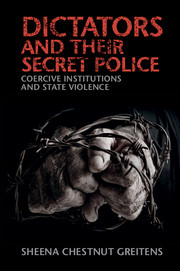Book contents
- Frontmatter
- Dedication
- Contents
- List of tables and fi gures
- A note on romanization
- Acknowledgments
- PART I THE PUZZLE AND THE ARGUMENT
- PART II THE ORIGINS OF COERCIVE INSTITUTIONS
- 3 Organizing coercion in Taiwan
- 4 Organizing coercion in the Philippines
- 5 Organizing coercion in South Korea
- PART III COERCIVE INSTITUTIONS AND STATE VIOLENCE
- PART IV EXTENSIONS AND CONCLUSIONS
- Appendix: A note on sources
- Index
- Miscellaneous Endmatter
5 - Organizing coercion in South Korea
from PART II - THE ORIGINS OF COERCIVE INSTITUTIONS
Published online by Cambridge University Press: 05 August 2016
- Frontmatter
- Dedication
- Contents
- List of tables and fi gures
- A note on romanization
- Acknowledgments
- PART I THE PUZZLE AND THE ARGUMENT
- PART II THE ORIGINS OF COERCIVE INSTITUTIONS
- 3 Organizing coercion in Taiwan
- 4 Organizing coercion in the Philippines
- 5 Organizing coercion in South Korea
- PART III COERCIVE INSTITUTIONS AND STATE VIOLENCE
- PART IV EXTENSIONS AND CONCLUSIONS
- Appendix: A note on sources
- Index
- Miscellaneous Endmatter
Summary
The Korean peninsula, a Japanese colony from 1910 to 1945, was effectively partitioned into Soviet and American zones of control at the end of the Second World War. Elections in the South in 1948, followed by the Korean War (1950–53), solidified this division. About a year after the 1960 April Revolution (or Movement) ended the presidency of the unpopular Syngman Rhee, a bloodless coup d'etat by Park Chung Hee in May 1961 established a military government in South Korea, which ruled until the 1963 elections put Park into the presidency. After a surprisingly close third-term re-election in 1971, Park declared martial law and assumed dictatorial power through the Yushin Constitution (유신) in autumn 1972. In October 1979, he was assassinated by the director of the KCIA, and power passed to General Chun Doo Hwan. Chun held the presidency until 1987, when power transferred to former General Roh Tae Woo, who kept his pre-election promise to democratize the country.
This chapter examines how Presidents Park Chung Hee and Chun Doo Hwan created and managed their coercive apparatus. Comparing two South Korean cases provides an opportunity to assess how two different autocrats’ threat perceptions shaped their coercive institutional choices for ruling the same country, and helps to examine the role of alternative explanations. If either external influence or path dependence was the best explanation for coercive institutional design, then we should observe very little difference between the coercive institutions of Park and Chun. Instead, the variation in their coercive institutional designs is striking. Consistent with previous chapters, this variation is best explained by the different threat perceptions of the two leaders.
The second section of this chapter illustrates that, unlike Taiwan, which organized itself to deal with popular unrest, or the Philippines, which was oriented toward elite threats, South Korea was first and foremost organized to deal with the external threat coming from North Korea. That threat prompted an unusually high degree of external (American) involvement in South Korea's coercive apparatus, including the retention of U.S. command authority over the Republic of Korea (ROK) military even under armistice conditions. The presence of an external threat and unusually high external influence limited the extent to which either autocrat was able to engage in coup-proofing fragmentation within the military, and imposed a national service requirement in which every South Korean male served in the military.
- Type
- Chapter
- Information
- Dictators and their Secret PoliceCoercive Institutions and State Violence, pp. 141 - 176Publisher: Cambridge University PressPrint publication year: 2016



